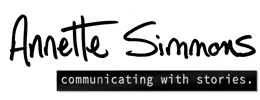This guy is in pain. I’ve seen this drawing from many people in many industries. The tug of priorities feel like they are tearing you apart. What I like about this guy’s drawing is the expressions on the faces of the people who need his attention. A nice person, a mad/mean person, a sad person, a clueless person, and the two handed power tug of a scared person. All priorities are not equal and yet the sense of urgency of the “tugger” is unrelated to the importance of the priority. This picture also gives the drawer a chance to see that he/she draws him/herself as a victim with no power. The question arises – Is that really true?
Pulled in too many directions
Facebook
Twitter
LinkedIn
Email
Print
Annette Simmons
Annette Simmons has travelled internationally while working with government, business, religious, and educational organizations. Her ability to deliver practical, easily implemented solutions when groups were antagonistic or deadlocked has gained her an international reputation in group dynamics.

2 thoughts on “Pulled in too many directions”
Annette, I think it can be true. There is some wonderful work by Barry Oshry in which he brilliantly describes the naturally arising dynamics of any human system. In the ‘Middle’ is where people will experience incredible tearing, being pulled in multiple directions, and there are ways that people increase this sense of tearing – thus powerlessness – and there are ways of managing it (you certainly can’t eradicate it, because its a naturally occurring dynamic). Its fascinating work.
And thanks for this website, its inspiring, I discovered your books many moons ago and yet only just landed on the site. Seasons best wishes to you, Steve
Hey Steve, Thanks for your comments! I’ll look up Barry Oshry. Any “middle” is hard – like taking care of parents and children at the same time. But what I’m finding is that women feel pulled apart at the top as well as in the middle. Women are wary of accepting top positions of power because the top positions don’t offer women the chance to do power like women want to do power. According to research, women’s identities prioritize moral identity as a bigger part of our personal identities. When we do that we judge ourselves by our own standards of what we should be doing with our power and the current systems don’t allow for moral choices that feel like the right thing to do but do not maximize quarterly profits. So being CEO ends up feeling more powerful to men than it does to many women.